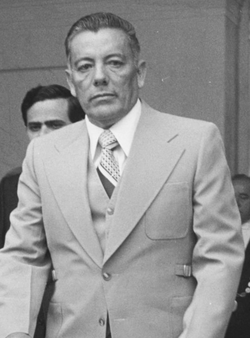Antonio Malito
Antonio Raffaelle Malito | |
|---|---|
 Malito in 1978 | |
| President of Adamantina | |
| Succeeded by | Ginevra Malito |
| Personal details | |
| Born | Antonio Raffaelle Malito September 8, 1910 Porto Pellegrini |
| Citizenship | Adamantina |
| Political party | Solidarista Party |
| Spouse | Ginevra Malito (m. 1935) |
| Children | 7 |
| Alma mater | Military Academy of the Adamantine Army |
| Occupation | Soldier, politican |
Antonio Raffaelle Malito (born 8 September 1910 – August 21 1989) was Adamantine general and politican. Serving as the Secretary of the Interior and as the Vice President of Adamantina from 1944 to 1948 he was elected President of Adamantina two times, serving from 1949 to 1953, when he was deposed by the Cabala delle Ombre. Malito was reelected in 1976 during the Asterian Spring, serving until his death in August 1989.
During his presidential terms, Malito was supported by his life-long wife Ginevra Malito, who served as his vice president and succeeded him after his death. Both were popular among the Adamantine working class. Malito worked to dignify labor and alleviate poverty throughout the country, and was widely supported by the institutionalized power of organized labor. From 1977 to 1989 he served as the President of the Confederation of Labor and Assembly of Industrial Organizations (CLA–AIO), and from 1949 to 1989 served as the Chairman of the Solidarista Party. During the military Junta of the Cabala delle Ombre, his party and supporters were banned from government, forcing many into exile. Throughout his term as president, the country saw periods of increased industrialization and prosperity, although during his last term the economy began to decline into recession.
Considered by many within political academia as a controversial figure, he and his wife are regarded as icons by those within the Solidarista Party.